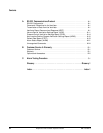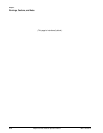
Chapter 2
2-6 Respironics V200 Ventilator Operator’s Manual REF 1057983 A
Warnings, Cautions, and Notes
ventilator to lose power. For further information, consult a service
technician or a trained biomedical technician.
• The ventilator is shipped with a power cord that complies with
electrical safety standards. Do not use substitute power cords
unless specifically instructed to do so by an authorized distributor
or qualified personnel. Do not modify the power cord or connect it
with electrical extension cords or outlet adapters.
• To prevent the risk of excessive leakage due to external equipment
being connected to the ventilator via the communication ports, a
means for external separation of the conductive earth paths must
be provided.
• All equipment used and connected to the ventilator
communications ports (analog, parallel, and serial) must comply
with the medical electrical equipment (IEC601-1) or other
applicable standards.
• The remote alarm port is intended to connect only to SELV (safety
extra low voltage and ungrounded system with basic insulation to
ground), in accordance with IEC60601-1. To prevent damage to
the remote alarm, the signal input should not exceed the
maximum rating of 24 VAC or 36 VDC at 500 mA with a minimum
current of 1 mA.
• Failure to protect the expiratory filter from damage by using
inappropriate patient circuit configurations may cause damage to
delicate ventilator components, such as the expiratory flow sensor,
which may lead to inaccurate spirometry or a Vent Inop condition.
• If clinical conditions do not require setting the HIP Limit above
60 cmH
2
O, we recommend the setting normally be adjusted to 60
cmH
2
O or less in order to prolong the operating life of the blower
and to maximize backup battery run time.
• The ventilator alarm indicators and the Alerts insert should be
monitored closely during the Alarm Silence period to ensure that
unexpected alarms are noticed.
• If an alarm persists for no apparent reason, contact Respironics
Customer Service at 1-800-345-6443.
• Care should be taken when cleaning the touch display. (Refer to
Figure 8-2 on page page 8-3). A soft moist cloth should be used
that does not drip water and/or soap solution when in contact with
the display. After cleaning and rinsing with a damp cloth, remove
all moisture with a dry, soft cloth. Never allow solutions of any
kind to collect on the bottom bezel of the display. Never use a
brush or device that can cause abrasion to clean the touch display
or its bezel; they will cause irreparable damage.
• Do not remove any screws from the cooling filter area. Removing
screws from this area will result in damage to internal
components.


















